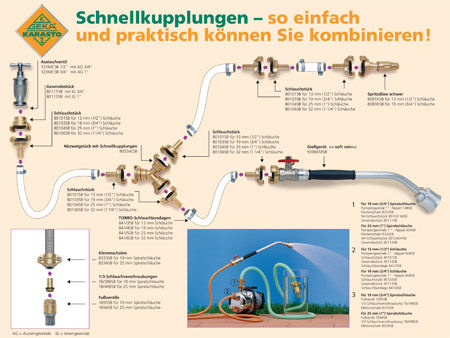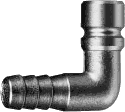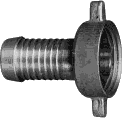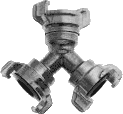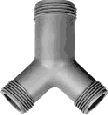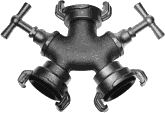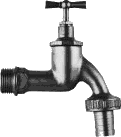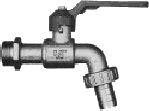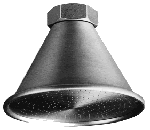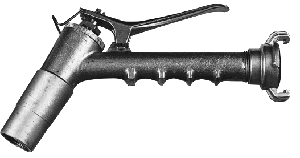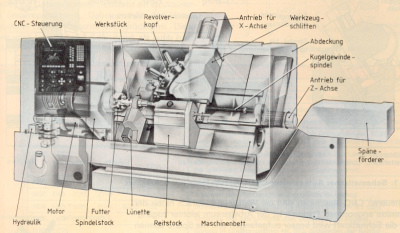FITTINGS GUIDE
1. A short extract from the history of KARASTO Armaturenfabrik Oehler GmbH, Fellbach
– The history of the GEKA quick coupling
The name of KARASTO is intimately associated with the very idea of the water hose fitting. KARASTO was founded in 1928 in Stuttgart-Gablenberg by Mr Julius Oehler. Relatively early in the history of our company, in 1931, Mr Oehler developed the GEKA quick coupler. He had the idea of making the Giersberg fire extinguisher coupling (the predecessor at the turn of the century to the present-day Storz coupling) compatible with conventional hoses by means of appropriate reduction and modification. The trademark “GEKA” is derived from the names of the Giersberg company = GE and KA = KARASTO. In 1932, the patent was granted for the GEKA quick coupling. The development of the GEKA quick coupling laid the foundation stone for an even more successful quick connector system for hoses. With the further development of the GEKA quick coupling into the GEKA plus quick coupling in 1999, this ingenious system underwent a 100% improvement in its technical data.
The product range at the beginning of the 1930s was very extensive, and many groups of items, some of which have been modified, are still to be found in our present-day range. Also produced in addition to the water hose fittings were compressed air fittings, gas welding fittings and atomiser nozzles. Likewise atypical for a fittings factory were the connection parts made of special bronze and copper for open-air electrical lines that featured in our range. The first contacts with dealers were established in the 1930s, and we are proud to say that many of them still belong to our active customer base. What started out as a small company underwent continuous development and, in 1951, moved into the newly-built manufacturing and administration building in Fellbach. Over the years the product range has been skilfully supplemented with the addition of new items and the existing range expanded.
The KARASTO fittings programme in its present form covers a wide range of fittings requirements for different industries.
In 1997, intensified development activities at KARASTO gave birth to the DVS air humidification system. This ingenious system can be used to regulate and maintain constant levels of humidity in many areas. In 2001, a central metering system was developed to supply up to 12 extraction points with various quantities of liquid. All the systems are representative of new product lines which are being developed in parallel with the familiar range of fittings and are grouped together in the new Climate Technology division. in 2003, KARASTO celebrated its 75th anniversary.
2. Water hose fittings
A rough overview of our water hose fittings is presented in the following. This paper cannot therefore claim to be exhaustive.
Water hose fittings are used to connect hoses to aggregates, with each other and to pipes, and to regulate water flow and jets. Today’s common materials for water hose fittings are brass and plastics. Threaded water hose fittings have pipe threads for connections that are not sealed in the thread. DIN ISO 228, part 1, (Whitworth pipe threads) therefore applies. The water hose fittings produced by KARASTO are all flat seal fittings. External flat seal threads have a flat surface at the beginning of the thread which is used in conjunction with the flat sealing ring of the parent part to create a seal. Female parts have a thread undercut at the end of the nozzle which takes a flat sealing ring.
In addition to the thread size, the complete characterisation of a water hose fitting also includes the nominal width NW (free passage/internal diameter) and the internal diameter of the hose IW.
When attaching water hoses to water hose fittings, the hose is pushed over the hosetail of the hose fitting. The length of the hosetail and its profile (ribbed markings) give the hose a certain amount of grip. Care must be taken to ensure that the ribbing on the hosetail is not too sharp-edged in order to prevent damage to the inside of the hose. The grip of the hose is further improved with the KARASTO hosetail profile through the addition of a raised end rib. The only way to securely attach the hose is, however, to use hose clamps (see point 2.19).
The following page shows different fitting combinations: (click on the figure to see it in full size)
2.1 GEKA plus quick couplings
As has already been stated, the GEKA plus quick coupling was derived from the Giersberg fire extinguisher coupling. The intention was to connect water hoses of different dimensions and qualities quickly and safely.
The important thing was and continues to be that no female and male parts are needed, as used to be the case. With all GEKA quick couplings, such as hose pieces, inner thread pieces and outer thread pieces, the coupling head with its claws (claw distance 40 mm) and its diagonal coupling strips is therefore identical.
GEKA couplings can be supplied hot-pressed in brass, in chrome-plated brass, plastic (glass reinforced polyamide), light metal (hot-pressed aluminium) and stainless steel (V4A, lost wax process). The integrated high-performance shaped sealing ring is supplied as standard in Perbunan rubber. For special applications it is also available in natural rubber, EPDM and FKM (fluorinated rubber) according to DIN ISO 1629. Construction and materials play a very important role in the seal. GEKA plus quick couplers connect water hoses from G 3/8 “(10 mm IW) up to G 1 1/2″ (38 mm IW). In the case of threaded pieces, all thread sizes from G 1/4 “(internal and external thread) up to G 1 1/2” (internal and external thread) are available. In addition, there is a dummy coupling for closure. GEKA plus quick couplings are used to connect water hoses with each other, to connect hoses to aggregates and to pipes and valves in industry, construction and agriculture, horticulture, and in private households.
Compared with copies of GEKA quick couplings, GEKA plus quick couplings have twice the operating pressure and offer substantial improvements in the low pressure range.
2.1.1 GEKA plus quick couplings for drinking water
 |
On 1 January 2003, the new drinking water regulation (TrinkwV) entered into force in Germany. This amended version of the TrinkwV pays closer attention to the components used in water installations, such as pipes, fittings and valves.
In the wake of the new TrinkwV, a new DIN standard, DIN 50930/6, was also adopted. This standard provides information on the stricter regulations that apply to the use of metallic materials that come into contact with drinking water. The permitted maximum levels in brass alloys, such as those of lead (Pb) and arsenic (As), were in some cases significantly reduced.
The brass alloys we use for our GEKA plus quick couplings already conform to the DIN 50930/6 standard and therefore offer maximum safety in drinking water installations.
Plastics and rubber parts must satisfy the KTW and DVGW W 270 requirements.
The TZW Karlsruhe test result has been in circulation since 16.12.2002. According to the survey result, our 300D seals meet the requirements of the KTW recommendations in the D2 seals range.
In a letter of 13.02.2004. we were informed by TZW Karlsruhe of the test results for our 300D shaped sealing rings in line with the DVGW worksheet W 270.
Assessment of the results for the D1 and D2 ranges (according to the KTW recommendation) is not currently possible because, according to an official letter from the main DVGW management, the preliminary assessment principles according to DVGW worksheet W 270 were abandoned on 12.06.2003 for areas D1 and D2.
If findings in accordance with W 270 are required for a certification process, the investigation report that we have for the seals area of application is sufficient.
2.1.2 GEKA Xplus quick couplings
GEKA Xplus quick couplings represent a combination of threaded ferrules and GEKA plus quick couplings.
For professional hose assembly, therefore, this is the cost-effective alternative to the use of crimping sleeves. Simple installation without an expensive installation tool (a wrench is enough).
During fixing, an absolutely flawless and firm connection of hose and fitting is achieved. This kind of fixing offers protection from accumulations of dirt between hose core and male hose end. No dead space can form, and optimum safety and hygiene standards are achieved. GEKA Xplus quick couplings are therefore eminently suitable for use in hoses that comply with the drinking water regulation.
2.2. GEKA 2000 hose and threaded pieces
Original GEKA 2000 quick couplings represent a logical extension and technical development within the GEKA family. The 360° axial rotation of the hosetails and threaded connections offers many advantages in daily use. Troublesome twists in the hose are prevented. Optimum hose protection and safety. No motion-related hazardous kinks in the hose.
2.3. GEKA suction and high pressure couplings
 |
 |
Due to their design, GEKA quick couplings can be used only in certain pressure ranges. For higher pressures, which obtain for example in pumping and pressure units, a further development was required as long ago as the beginning of the 1960s. With GEKA suction and high-pressure couplings the entire hosetail plus gasket is inserted into the coupling head and can be screwed in with a screw ring with the opposite side, seal against seal. With the described design principle, a pressure resistance of up to approx. 80 bar can be achieved. Water hoses of different dimensions and qualities can quickly be coupled with each other, and also with suction and high-pressure couplings. All GEKA suction and high-pressure couplings can be combined with each other as well as with GEKA quick couplings. Suction and high-pressure couplings are manufactured from hot-pressed brass parts and brass turned parts. For the plastic design, which is used among other things for breathing apparatus, polyoxymethylene and low-pressure polyethylene are used. Depending on the application, the sealing rings, which are made from perbunan rubber as standard, can also be supplied in natural rubber and FKM (fluoridised rubber) according to DIN 1629 ISO. To achieve the necessary resistance to pressure, the sealing ring is stabilised with an inner brass ring. GEKA suction and high-pressure couplings made of brass are available for water hoses from 1/2” (13 mm IW) to 1 1/4″ (32 mm IW) as well as with external thread (for thread G 3/4” and thread G 1”). With plastic suction couplings the range is limited to 3/4” (19 mm IW) and 1″ (25 mm IW) hose pieces and the externally threaded part G 3/4″. Suction and high-pressure couplings are used for water, suction and high-pressure hoses, pressure and pumping units in industry, construction and agriculture, horticulture, and in private homes.
2.4. Push-fit systems made of brass and plastic
The metal push-fit connectors familiar from the gas and pressurised air field were modified at the beginning of the 1960s to make them usable in water hoses.
A push-fit system consists of sockets and plugs. With sockets, a distinction is made between sockets with internal and external threads and sockets with self-closing valves. Plugs are offered as hose connectors, threaded plugs, etc. The range is rounded off with other variants. These are less important than the plastic plug range.
In the mid-1960s, the GARDENA company pulled off a double innovation: they replaced the previously standard couplings with clamps with an easily attachable connector and started the well-known metal push-fit couplings out of plastic. The result was the GARDENA hose push-fit system.
The plastic push-fit hose systems and their clever accessories are indispensable in the private households and gardens of today.
2.5. KARASTO 2000 threaded hose fittings
The new generation, a logical extension and technical development within the KARASTO water and industrial hose fitting family. The 360° axial rotation of the hose nozzles and threaded connections even under pressure or suction offers many advantages in daily use. Troublesome twists in the hose are prevented. Optimum hose protection and safety. No motion-related hazardous kinks in the hose.
2.6. 1/3 threaded hose fittings with flange and O-ring
This type of threaded hose fitting is used mainly to connect hoses to aggregates with an internal thread. The O-ring with the 1/3 threaded hose fitting dispenses with the need for other sealing materials such as hemp or Teflon. The fittings described in this chapter are typically turned parts made of brass.
2.7. 1/3 threaded hose fittings “Sauger” with hexagon
Suction pieces are also used to connect hoses to units with internal thread. Flat sealing rings are generally used as seals. The hexagon between the hosetail and thread is used in conjunction with a wrench as a screwing aid. Suction pieces can be bought as turned and hot-pressed parts.
2.8. KARASTO threaded hose fittings (heavy duty)
KARASTO threaded hose fittings are available as 1/3, 2/3, and 3/3 threads. Designations in common use are male part, female part and whole thread. All hosetails are turned brass parts and the heavy-duty toggle cap nuts are made of pressed brass. To improve the hose seat, the hosetail of KARASTO hose fittings has a higher end rib. To connect hoses with one another, a 1/3-hose fitting (male part) and a 2/3-hose fitting (female part) are used. A 3/3 thread (whole thread) is caused by the aforementioned combination. 2/3 threaded hose fittings with toggle cap nuts or knurled nuts are used to connect hoses to bibcocks and aggregates with an external thread are used with knobs or knurled nut. Until the late 1960s, the hose thread described here was, in addition to GEKA quick coupling, the classic system for connecting water hoses with one another. The use of the plastic push-fit system has given rise to an application-related division in the consumer market. KARASTO hose fittings are used in industry and in commercial horticulture.
2.9. Threaded hose fittings (lightweight version)
Lightweight threaded hose fittings are the counterpart to KARASTO threaded hose fittings. They are also made of brass. The toggle cap nuts and hose connectors are, however, manufactured using the pressure casting process. In addition to manufacturing-related differences they have slightly thinner walls. Shorter lengths are also to be found, and the higher end rib is missing. Light threaded hose fittings are inexpensive and are used mainly in commercial horticulture and hobby gardening.
2.10. 2/3 angled threaded hose fittings 90°
90° threaded hose fittings are used wherever a particular hose guide is necessary or in order to prevent kinking of the hose. The angled connectors are cast from brass, the toggle cap nuts with internal thread are hot-pressed brass parts (bright brass or chrome-plated brass). Plastic versions (e.g. polypropylene) are also used for many applications.
2.11. Stand pipe fittings
Stand pipe fittings consist of a threaded nipple and a 2/3 fitting and serve to connect hoses to aggregates and pipes. Stand pipe fittings are available with internal or external thread on the nipple side, depending on the thread of the connected aggregate. As with the threaded hose fittings, a distinction is made between a heavy version made of turned brass parts with a raised end rib on the hosetail, and cheaper stand pipe fittings, in whose case the brass connectors are manufactured using the die-cast process. Compared to 1/3 threaded hose fittings and suction pieces, the benefit of stand pipe fittings is that hoses can be attached and removed without twisting.
2.12. KARASTO 2000 threaded nipples
The new generation, a logical extension and technical development within the KARASTO fitting family. The 360° axial rotation of the threaded connections even under pressure or suction conditions offers many advantages in daily use (not suitable for use a bearing for continuous operation.)
2.13. Threaded nipple with hexagon
We’ve already looked at threaded nipples in stand pipe fittings. (These are used as stand pipe fittings in combination with 2/3 fittings.) Furthermore, threaded nipples offer a versatile range of uses as connecting elements for pipes, generators, machinery, etc. For different applications there are threaded nipples with external threads, reducing threaded nipples with external threads, threaded nipples with internal/external threads and reducing threaded nipple with external/internal threads. Threaded nipples are manufactured as brass turned parts and brass castings in dependence on the thread sizes and nominal diameters. The use of flat seals is advisable due to the non-sealing property of the Whitworth pipe thread in the thread itself.
2.14. Branch pieces
Branch pieces are used to connect branching hoses at the supply end or to add in branches within serial lengths of hose. The simple form of the branch piece has an internal thread (e.g. for connection to a drain valve) at the inflow and an external thread at both outflow ends. Versions of branch pieces that are easier to use are available in an assembly with GEKA quick couplings. The material used is brass (hot-pressed parts). In some cases, cast brass is also used, although it should be noted here that pressure-casting-related faults such as leaks cannot be entirely avoided. In special cases, where lightness and resistance to certain media are needed, branch pieces made of plastic (e.g. glass reinforced polyamide) are used.
2.15 Two-way valves
Two-way valves are branch pieces in which the two outflow ends can be closed off using valves. Ball valves are also used in addition to the conventional valve mechanisms. A distinction is made between two-way valves with internal / external thread, with swivel nut and external thread and with GEKA quick couplings.
2.16 Hose connections
Threaded hose fittings are still a tried-and-tested way to easily connect, repair or extend hoses. As an alternative to these, connections using GEKA quick couplings or threaded hose connections are available. Hose connections can broadly be classified in the following categories:
– KARASTO hose connections, heavy-duty, brass, turned parts with raised end ribs
– Medium duty, brass (die casting)
– Lightweight, brass sheet, pressed
– KARASTO hose connections made of plastic (polyethylene) with raised end ribs
– Hose connections made of plastic (acetal copolymer), straight, T-shaped, L-shaped and Y-shaped
2.17. KARASTO spray nozzles (heavy duty)
The basic form of the KARASTO spray nozzle emerged at the beginning of the 1930s in the KARASTO company. Over the years it has undergone further developments and improvements. The construction principle makes it possible to turn off the water flow and permits infinitely gradated adjustments from spray to full jet. KARASTO nozzles are available with hose connectors, internal threads, external threads and GEKA quick couplings. All metal parts are made of brass (hot-pressed parts) and turned parts. The built-in sieve plate with sealing cone consists of a brass cone which is insert moulded with polyamide. KARASTO spray nozzles differ from their copies in that KARASTO spray nozzles are sealed via a brass cone (metal on metal) in the mouthpiece and, at the supply end at the rear, with an O-ring. Heavy-duty spray nozzles are used in industry, in the construction industry, in commercial horticulture etc. A relatively powerful jet of water can be achieved at full jet setting.
2.18. GEKA garden spray nozzles (Siro spray nozzles)
The GEKA garden spray nozzle is based on a design and production principle originated by the Schatt Company in Nuremberg. Schatt was incidentally the oldest fittings factory in Germany, proven to date back 800 years. GEKA garden spray nozzles can likewise be switched off and have an infinitely adjustable range of settings from spray to full jet. They can be supplied with hosetails for different hose sizes, and with GEKA quick couplings. GEKA garden spray nozzles are sealed with a sealing plate embedded in the spray head against the spray cap. Pressed and turned brass parts are used in GEKA garden spray nozzles. The spray head is made by insert moulding brass parts with an acetal copolymer. Used mostly as a gardening spray nozzle, it is progressively being replaced by plastic push-fit spray nozzles.
2.19. Bibcocks
Well-known for their versatile range of uses in industry, household, gardens, etc. bibcocks are common fittings that are of course used to connect water hoses. For optical and durability reasons, a distinction is made between designs in matt brass, polished brass, matt chrome-plated brass and polished chrome-plated brass. The valve shells used for bibcocks are sealed with a rubber seal. As is well known, water hoses are connected to bibcocks using 2/3 threaded hose fittings with toggle nuts/knurled nuts or GEKA quick couplings. For special application purposes, a non-return valve with aerator is fitted between the 2/3 fitting and the bibcock. The right kinds of bibcocks have a growing market share and are mainly used in households. Bibcocks are usually made of brass (hot-pressed and cast).
2.20. Ball bibcocks
In comparison to conventional bibcocks, ball bibcocks offer certain advantages. The leaks (rubber sealing washer, valve shell) for which bibcocks are known are virtually unheard-of with ball bibcocks. Ball bibcocks guarantee the free passage of water when open, whereas with bibcocks the valve sealing washer impacts negatively on the flow even when fully open. In ball bibcocks, the body is made of hot-pressed brass with a protective layer of nickel plating. The ball also consists of brass and is hard-chromium-plated. Steel balls are employed for simple models, but premature corrosion is likely here. Teflon sealing rings act as a sealing element. With the operating levers, there are versions made of painted die-cast aluminium and models made of variously treated steels.
2.21. Foot valves
Foot valves are used in combination with pump units. They are mounted at the end of a suction hose. The valve mechanism, consisting of a valve plate with gasket and spring, prevents the water in the hose between the foot valve and pump from running out when the pump is switched off. When the pump is restarted, full suction power is thus immediately available. To protect the pump a strainer is attached to the valve body, which is intended to catch any coarse dirt particles which may be in the water. The strainer can be either a fine mesh stainless steel mesh or a slotted brass cylinder.
2.22. Hose clamps, clamps
Hose clamps are an important tool for the attachment of water hoses. As a rule, the design features referred to in point 2 do not suffice to keep a pressurised hose securely on the hose connector. In the early days of water hose fittings the hose was secured to the connector by means of a wire that was drawn tight over the end of the hose. The development of hose bandages represented a more convenient and safer way of attaching hoses. Hose bandages consist of steel straps of different widths. The bandage is embossed for the purpose of transport of the hose strap inside the screw housing. The form of the band edges is very important due to the risk of damage to the hose. Chromium steels or galvanized steels are used to prevent corrosion. As is well known, there are hoses with different internal diameters and different outer diameters. Hose bandages with appropriate clamping areas are offered for this reason. By turning the screw in the screw housing the hose strap is pulled and the hose is pressed firmly onto the connector. Hose clips offer an alternative to hose bandages. With hose clips, the steel strip is pulled taut using a lock. For higher pressure, clamps (see picture) and hydraulic connections are used.
2.23. Pot watering equipment and accessories
2.23.1 Pot watering equipment
GEKA pot watering equipment is specifically designed for the gentle watering of plants. A rich variety of different watering heads guarantees a soft mist of water that comes close in its effect to natural rain. Depending on the equipment in question, either one-hand quick-action valves or ball valves are used to regulate the quantity. The aluminium discharge pipes are available in different lengths.
2.23.2 Accessories
GEKA pot watering equipment can be combined with a variety of different watering heads and nozzles. The selection of watering head is based on the area to be watered, the type of water mist and the material (brass, stainless steel, aluminium). Stainless steel components should be used for water to which fertiliser is to be added.
2.24. GEKA watering showers
The GEKA watering shower is a handy device for water metering for outdoor plants and greenhouse crops. Like the pot watering equipment, it can be combined with a variety of spray heads and jets.
3. Materials for water hose fittings – production of water hose fittings
3.1. Materials for water hose fittings
For water hose fittings, the most commonly used materials are plastics and metal alloys. The choice of material depends on the necessary resistance and the required strength properties (pressure, tension, etc.).
Metal alloys
The dominant metal alloy used is brass (CW 617 N or CW 614 N), which either shiny, chrome-plated or nickel-plated. in terms of production (protoplasts, forming, shape cutting etc.) and because of its resistance to certain influence media, brass represents a good compromise. The strength values are sufficient in dependence on the structure of the metal and the wall thickness. In no particular order of effectiveness, other metal alloys worth mentioning are aluminium alloys and stainless steel.
Plastics
Although the plastics of today exhibit an attractive range of properties with regard to strength and resistance values, end users still tend to gravitate towards metal in cases of doubt. This having been said, plastics occupy a solid niche in water hose fittings. Modern injection moulding technology makes it easy and cost-effective to produce complex part geometries. References to the brand and, consequently, the producer take the form of special colouring of the plastic products. In dependence on the requirements to which a plastic fitting is subjected on the market, the appropriate plastics can be selected from the rich palette of available plastics. For water hose fittings, the plastic types that are typically used are acrylonitrile-butadiene-styrene, acetal resins, polyethylene, polypropylene and polyamide. The use of plastic water hose fittings is safe in normal water supply pressure ranges and at normal temperatures. In their resistance to influence media, they are in many cases superior to metal alloys.
Seals
Seals, as the name implies, are very important components in fittings. Taking into account different pressures, temperatures, food and drinking water resistance, and media, they contribute to the leak-tightness of the product. They are used both with and without fabric reinforcement. Without claiming to be exhaustive, NBR, FKM (fluoridised rubber) according to DIN ISO 1629, FPM, PVC, EPDM and Cobrit etc. are among the materials used.
3.2. Production methods for water hose fittings
The following production methods have been selected in order of their popularity in the manufacture of water hose fittings. Certain variants have not been included.
Machining shaping (turned parts)
Machining is a very common manufacturing processes. Hosetail shapes, threads, thread undercuts, holes etc. can be produced with special cutting tools. The machines used are lathes, automatic lathes, machining centres and special machines. The source materials for production of brass fittings are brass pipes and brass rods, which are available in standardised dimensions. Turned parts in the area of the water hose fittings include 1/3 fittings, threaded nipples, hose connections, etc.
CNC lathe
Hot forming (forgings)
One example of hot working is the reforming of a cylindrical section of a brass rod into the raw form of a GEKA coupling. Divided into individual manufacturing stages, this can be pictured as follows:
A cylindrical section of a brass rod (brass tube) is heated in a furnace to approx. 700°C. The red-hot part is inserted into the pressing tool of a hydraulic press. The pressing tool consists of a top and a bottom part in which cavities are incorporated which match the shape of a GEKA quick coupling. Fast closure of the tool halves under pressure forces the material into the mould. The result is the GEKA plus quick coupling. Excess material which comes out of the mould split line and forms a ridge must be removed in a subsequent operation. Further important operations such as machining (thread, connector form, seal seat, hole), pickling and ball polishing follow, finally resulting in a sellable GEKA plus quick coupling.
With brass forgings, the grain is preserved in the metal and the metal structure is refined. The hot working process is suitable for ferrous and non-ferrous metals. Typical hot-pressed parts are the GEKA plus quick couplings, toggle cap nuts for 2/3 fittings, mouth pieces for spray nozzles etc.
Casting (pressure die casting)
The production of castings is in many cases more economical than that of turned parts and forgings. Expensive brass rods and brass tubes are not needed. Some brass waste can be used. From the numerous casting methods for brass hose fittings, the one that has come to the fore is die casting. In die casting, a molten mass of brass is pressed under pressure and at high speed into a heated multi-part mould. Thin-wall fittings with complex shapes can in this way be produced accurately and with good surface quality.
Depending on the design of the pressure casting mould, multiple fittings can be created in one form so that several parts can be manufactured at the same time in one production cycle. Die casting is a mechanically simple and fast production process, with few or no reworking passes. The disadvantages of castings compared to turned parts and forgings are their low resistance value and the cavities that can form. Cavities can be cause of leakage and a potential starting point for material breaches. In some cases, castings must undergo further machining. 1/3-hose fittings (light version), suction pieces, hose connections etc. are typically made using the pressure casting process.
Plastic injection moulding process
The plastic injection moulding process is indispensable to our modern technology. The diversity of the plastic parts used in the automotive, electrical, medical, household, tool production and plumbing fields can only be economically produced using the plastic injection moulding process.
In the plastic injection moulding process, a molten mass of plastic is injected by an injection moulding machine under pressure and at high speed into a temperature-controlled injection mould. Thin-walled parts with complex shapes can be produced accurately and with high surface quality. The fact that one single form can contain multiple parts allows for a high volume output per production cycle. Depending on the production quality, left-over material and defective parts can be crushed and returned to the production process.
The plastic injection moulding process is used for almost all plastic hose fittings.


